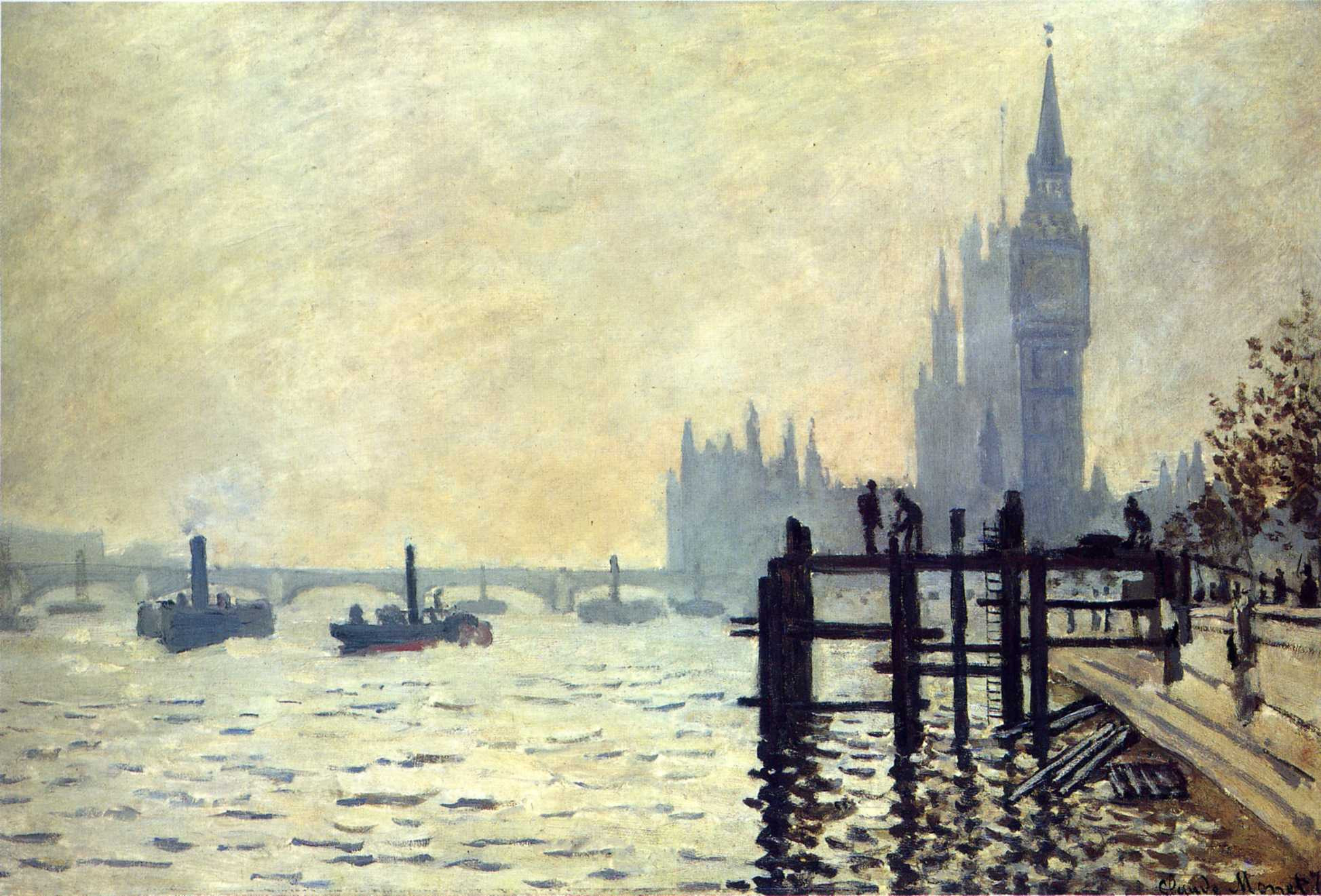
Meaning of The Thames below Westminster by Claude Monet
A Masterpiece of Light, Atmosphere, and Subtle Symbolism
Claude Monet’s The Thames below Westminster is more than a depiction of a foggy London riverscape, it is a masterful interplay of light, color, and form that captures the fleeting moment and atmospheric mood of the modern metropolis. Painted in 1871 during Monet’s stay in London, this work not only exemplifies the early roots of Impressionism but also reflects the artist’s evolving approach to landscape painting. In this post, we will delve deeply into the context, techniques, symbolism, and significance of this iconic painting, offering a detailed analysis of what Monet sought to express and why the work continues to resonate with audiences today.
What Is The Thames below Westminster Painting All About?
The Thames below Westminster (1871) is an oil painting created by Claude Monet, one of the founding figures of the Impressionist movement. The painting captures a view of the River Thames in London, with the Houses of Parliament and Westminster Bridge shrouded in misty, golden light. It was painted during Monet’s temporary exile in London following the Franco-Prussian War.
On the surface, the painting appears to be a simple landscape or cityscape. However, the work is deeply infused with Monet’s fascination with transient light and atmospheric effects. This was a turning point for the artist, he was beginning to move away from detailed realism and toward the freer, more emotive style that would define Impressionism.
The scene presents the embankment near Westminster, with leafless trees, a wooden pier in the foreground, small boats on the river, and the iconic silhouette of Parliament rising in the background. A calm yet complex representation of a modern city caught in a natural, almost poetic haze, the painting straddles the line between the built environment and the evanescence of nature.
Monet in London: A Turning Point
Claude Monet fled to London in 1870 with his wife Camille and their son to escape the Franco-Prussian War. The city offered not only refuge but also artistic inspiration. Monet found London’s fog, weather, and architecture mesmerizing, and it was during this stay that he began to seriously explore the idea of painting light and atmosphere as primary subjects.
In 1871, Monet began work on a small group of paintings depicting the Thames and its surroundings. The Thames below Westminster is one of the earliest of these works and represents an initial foray into themes he would revisit in greater depth in his later series of the Houses of Parliament painted in the early 20th century.
Artistic Influences
While in London, Monet was also exposed to the works of English landscape artists such as J.M.W. Turner and John Constable, whose atmospheric landscapes and use of light deeply impressed him. Turner’s hazy, dreamlike depictions of natural scenes in particular resonated with Monet’s own artistic sensibilities.
Moreover, London’s urban environment, with its industrial smokestacks, bridges, and endless mist, was in stark contrast to the rural French landscapes Monet had been painting. This shift in setting gave rise to new themes: the intersection of modernity and nature, the changing environment, and the impact of urbanization on perception and emotion.
How Monet Created The Thames below Westminster Painting
Oil on Canvas and the Impressionist Touch
The Thames below Westminster is executed in oil on canvas, measuring approximately 47 x 73 cm. The painting exhibits several hallmarks of early Impressionist technique, though it is more restrained than Monet’s later, more fluid works.
Monet builds the image with thin, layered brushstrokes that shimmer with variations in tone and color. The texture is relatively smooth, but the attention to light and atmosphere is clear. The palette is soft and subdued: gentle blues, greys, golds, and earthy browns dominate, reflecting the filtered light of a foggy London day.
Capturing Light and Atmosphere
One of Monet’s primary goals was to paint not objects, but the effect of light upon them. In this work, light is diffused and muted by the fog. The sky and water blend into each other, creating a harmonious transition between air and earth. The buildings of Westminster are partially obscured, softened by mist, a deliberate choice to emphasize their ephemeral presence rather than their architectural detail.
The composition is horizontal and stable, with strong linear elements, the embankment, the pier, the river, all grounding the scene. Yet, the entire image feels fluid and transient, as if the city is on the verge of disappearing into the vapor.
Use of Perspective and Space
Monet’s choice of viewpoint is also notable. He places the viewer not on the bridge itself or facing Parliament directly, but slightly downriver, where the angle offers a side profile of the Gothic architecture. This vantage point increases the sense of distance and detachment. The spatial depth is emphasized by the pier in the foreground, leading the eye across the water toward the buildings in the back.
The painting plays with layers: foreground (pier and embankment), middle ground (boats and river), and background (Parliament and bridge) are not clearly delineated. Instead, they dissolve into one another through the shared atmosphere, a visual metaphor for interconnectedness and impermanence.
4. Symbolism and Deeper Meaning
Though Monet was not overtly symbolic in the way of Romantic or Symbolist painters, The Thames below Westminster can be read on several metaphorical levels.
Fog as a Symbol of Modernity and Mystery
The fog in the painting is not just a meteorological phenomenon; it becomes a metaphor for uncertainty, industrial transformation, and the unknowable future. In 19th-century London, fog was both a natural and man-made product, enhanced by coal-burning factories and urban congestion. For Monet, this fog was a veil that both revealed and obscured. It softened the harsh outlines of the city, turning it into something almost mythic and timeless.
Nature and Civilization in Tension
Monet’s inclusion of bare trees and the old wooden pier contrasts with the looming presence of Parliament and the modern embankment. This juxtaposition suggests a quiet tension between the natural world and the encroaching modern city. Yet, it is not a violent or aggressive opposition, it is contemplative and melancholic. The leafless trees, silhouetted in the mist, evoke a kind of poetic sorrow for what is being lost amid progress.
Transience and the Impressionist Ethos
At its heart, The Thames below Westminster is about impermanence, a key theme of Impressionism. Nothing in the scene is static. The light changes, the fog moves, the river flows. Even the mighty Parliament appears softened and mutable. Monet’s brush captures a single moment in time, knowing that it will never come again in quite the same way.
This focus on the ephemeral speaks to a broader philosophical idea, the importance of the present moment, and the artist’s role in capturing fleeting impressions before they vanish.
What’s Happening in the Painting?
Though The Thames below Westminster is not a narrative painting in the traditional sense, there is a quiet story being told.
It is a cold, foggy morning or afternoon. The city is waking or perhaps fading into twilight. A few small boats float on the river, their figures obscured. The embankment is nearly empty, only a few indistinct silhouettes can be seen. The trees are bare, suggesting late autumn or winter. The Parliament building stands in the background, half-lost in mist, its power subdued by nature’s embrace.
The scene conveys a moment of quiet solitude, as if time itself has slowed down. It’s a reflection of the modern urban experience: anonymity, reflection, and the beauty of stillness in a bustling world.
6. What Type of Art Is The Thames below Westminster?
Monet’s painting is best categorized as Impressionist, though it predates the first official Impressionist exhibition (which took place in 1874). In fact, this work is considered a proto-Impressionist piece, bridging the gap between Realism and the full-blown Impressionist style that Monet would help define.
Key elements of Impressionism in this work include:
Focus on light and color over precise detail
Loose brushwork and atmospheric perspective
Modern urban subject matter
Interest in capturing a moment in time
At the same time, the painting retains a degree of structure and clarity that links it to earlier landscape traditions. It is not yet the explosion of color and abstraction that would characterize Monet’s later work.
Where Is The Thames below Westminster Painting Located Today?
Today, The Thames below Westminster is housed in the National Gallery in London, United Kingdom. It is part of the gallery’s esteemed collection of 19th-century European painting.
The National Gallery provides visitors with an opportunity to view the painting in the city where it was conceived, offering a unique connection between the artwork and its subject. Visitors often find themselves comparing Monet’s interpretation of the Thames with the modern reality just outside the museum’s doors.
Why The Thames below Westminster Still Matters
The Thames below Westminster is more than a landscape painting, it is a quiet revolution in how we see and depict the world. Through subtle brushwork, muted color, and an eye for the ephemeral, Claude Monet created a work that invites contemplation and reflection.
It reminds us of the power of the moment, the beauty in the everyday, and the mystery that lies beneath even the most familiar scenes. As the Thames flows endlessly past the foundations of Westminster, so too does time slip past us. Monet’s genius was to catch a single shimmer of that passing, and to preserve it forever in paint.
In this painting, the real and the unreal meet. The permanence of Parliament fades in fog. The stillness of water holds invisible motion. And the viewer, standing in a gallery or before a reproduction, is drawn not just to look, but to feel. image/wikiart




